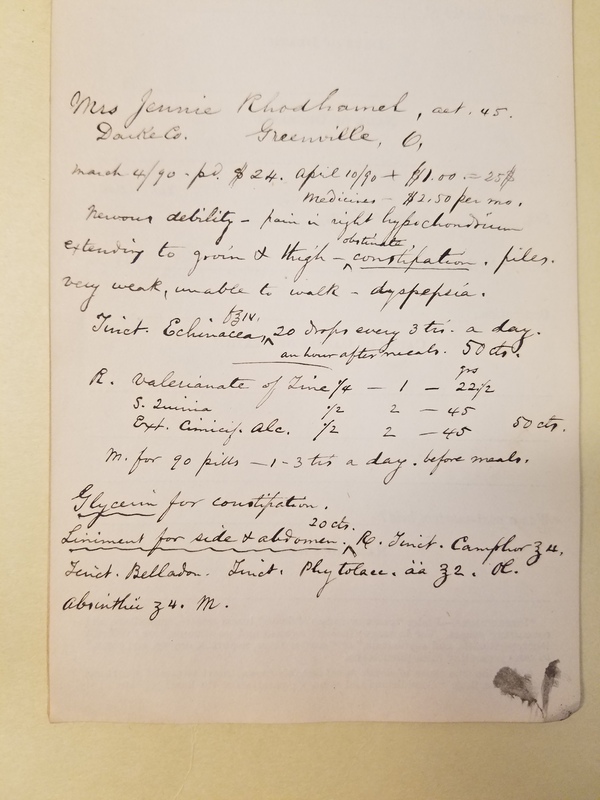Mrs Jennie and Nervousness, Example of Herbal Treatments for Anxiety
TRANSLATION OF TEXT IN IMAGE
Mrs. Jennie Rodhamel, age? 45.
Darke Co. Greenville, Ohio
March 90-pd 24$. April 10/90 + 1 = 25$
Medicines–2.50 per month.
Nervous debility– pain in right hypochondrium extending to groin and thigh, obstinate constipation, piles (hemorrhoids). Very Weak, unable to walk, dyspepsia. (stomach upset)
RX Tincture of Echinacea 20 drops every three times a day, an hour after meals. 50 cts?
Rx Valerinerate of zinc ¼ –1–22/2 grains?
- Quinia? ½—1-45/ grains? (sulfate of quinia)
Ext. (Extract) Cimicif. Alc. (Cimicifuga or Black Cohosh) ½–2–45 /grains
- for 50 pills 1-3 times a day before meals. 50 cts.
Glycerin for constipation.
Liniment for side and abdomen 20 cts. RX tincture of camphor, 4 ounces, Tincture of Belladonna, Tincture phytolacca. 2 oz mix with absinthe 4 ounces.
Mrs. Rodhamel suffered from nervousness and right abdominal pain, constipation, hemorrhoids, and stomach upset. She was unable to walk, and that right there makes you wonder what she suffered from. Did she have something more significant than just nervousness? Did he charge her a considerable amount for therapies to treat anxiety rather than probably an underlying severe disease like cancer? Liver disease? Regardless, she was charged 25 dollars for a visit, and the medicines were 2.50 cents a month. Approximately 780 dollars for her stay in today’s dollars adjusted for inflation. As illustrated in these cases, women who saw Dr. King were not poor.
The herbal remedies above may be recognizable to you. Echinacea is used today as a herbal remedy to prevent colds. Valerian was used for hysteria and is now used for anxiety. The Sulfate of Quinia, a derivative of quinine, was used for fevers and black cohosh All of these, except quinine, are in common herbal supplements even today. Quinine, extracted from cinchona bark, has a long history. An excellent book on the early history of the bark is Matthew Crawford’s The Andean Wonder Drug: Cinchona Bark and Imperial Science in the Spanish Atlantic, 1630–1800.
Going back to poor Mrs. Rodhamel, she was given glycerin for constipation, which is used daily in hospitals today as suppositories for constipation.
Dr. King’s balm is full of readily absorbable treatments for pain that included belladonna, absinthe (also has a long history), and pokeweed. The only part of this tincture that is now easily accessible is camphor for muscle aches. I found this prescription interesting as so many of these ingredients are still in use today and are recognizable to medicine. Yet, only a few are regulated, like quinine.
These first cases show some of the common treatments for female diseases, that eclectic physicians prided themselves on herbal treatments. Their beliefs about female emotional states like anxiety, hysteria, and female sexuality were typical for the 19th century. In the history of the next case, female sexuality was considered dangerous and led to drastic herbal treatment.
